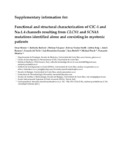Mostrar el registro sencillo del ítem
Functional and Structural Characterization of ClC-1 and Nav1.4 Channels Resulting from CLCN1 and SCN4A Mutations Identified Alone and Coexisting in Myotonic Patients.
| dc.creator | Brenes García, Oscar Gerardo | |
| dc.creator | Barbieri, Raffaella | |
| dc.creator | Vásquez Cerdas, Melissa | |
| dc.creator | Vindas Smith, Rebeca | |
| dc.creator | Roig Fernández Jeffry | |
| dc.creator | Romero Vásquez, Adarli | |
| dc.creator | del Valle Carazo, Gerardo | |
| dc.creator | Bermúdez Guzmán, Luis | |
| dc.creator | Bertelli, Sara | |
| dc.creator | Pusch, Michael | |
| dc.creator | Morales Montero, Fernando | |
| dc.date.accessioned | 2021-10-20T20:39:57Z | |
| dc.date.available | 2021-10-20T20:39:57Z | |
| dc.date.issued | 2021 | |
| dc.identifier.citation | https://www.mdpi.com/2073-4409/10/2/374 | |
| dc.identifier.uri | https://hdl.handle.net/10669/84656 | |
| dc.description.abstract | Non-dystrophic myotonias have been linked to loss-of-function mutations in the ClC-1 chloride channel or gain-of-function mutations in the Nav1.4 sodium channel. Here, we describe a family with members diagnosed with Thomsen’s disease. One novel mutation (p.W322*) in CLCN1 and one undescribed mutation (p.R1463H) in SCN4A are segregating in this family. The CLCN1-p.W322* was also found in an unrelated family, in compound heterozygosity with the known CLCN1-p.G355R mutation. One reported mutation, SCN4A-p.T1313M, was found in a third family. Both CLCN1 mutations exhibited loss-of-function: CLCN1-p.W322* probably leads to a non-viable truncated protein; for CLCN1-p.G355R, we predict structural damage, triggering important steric clashes. The SCN4A-p.R1463H produced a positive shift in the steady-state inactivation increasing window currents and a faster recovery from inactivation. These gain-of-function effects are probably due to a disruption of interaction R1463-D1356, which destabilizes the voltage sensor domain (VSD) IV and increases the flexibility of the S4-S5 linker. Finally, modelling suggested that the p.T1313M induces a strong decrease in protein flexibility on the III-IV linker. This study demonstrates that CLCN1-p.W322* and SCN4A-p.R1463H mutations can act alone or in combination as inducers of myotonia. Their co-segregation highlights the necessity for carrying out deep genetic analysis to provide accurate genetic counseling and management of patients. | es_ES |
| dc.description.sponsorship | Universidad de Costa Rica/[]/UCR/Costa Rica | es_ES |
| dc.description.sponsorship | Fondazione AIRC per la Ricerca sul Cancro/[IG 21558]/AIRC/Italia | es_ES |
| dc.description.sponsorship | Italian Research Ministry/[PRIN 20174TB8KW]//Italia | es_ES |
| dc.language.iso | eng | es_ES |
| dc.source | Cells, vol.10(2), pp.1-20 | es_ES |
| dc.subject | Myotonia | es_ES |
| dc.subject | Chloride channel | es_ES |
| dc.subject | Sodium channel | es_ES |
| dc.subject | Xenopus oocytes | es_ES |
| dc.subject | Electrophysiology | es_ES |
| dc.subject | Structure analysis | es_ES |
| dc.subject | MYOTONIA CONGENITA | es_ES |
| dc.title | Functional and Structural Characterization of ClC-1 and Nav1.4 Channels Resulting from CLCN1 and SCN4A Mutations Identified Alone and Coexisting in Myotonic Patients. | es_ES |
| dc.type | artículo original | |
| dc.identifier.doi | 10.3390/ cells10020374 | |
| dc.description.procedence | UCR::Vicerrectoría de Docencia::Salud::Facultad de Medicina::Escuela de Medicina | es_ES |
| dc.description.procedence | UCR::Vicerrectoría de Investigación::Unidades de Investigación::Ciencias de la Salud::Centro de Investigación en Neurociencias (CIN) | es_ES |
| dc.description.procedence | UCR::Vicerrectoría de Investigación::Unidades de Investigación::Ciencias de la Salud::Instituto de Investigaciones en Salud (INISA) | es_ES |
| dc.description.procedence | UCR::Vicerrectoría de Docencia::Ciencias Básicas::Facultad de Ciencias::Escuela de Biología | es_ES |



